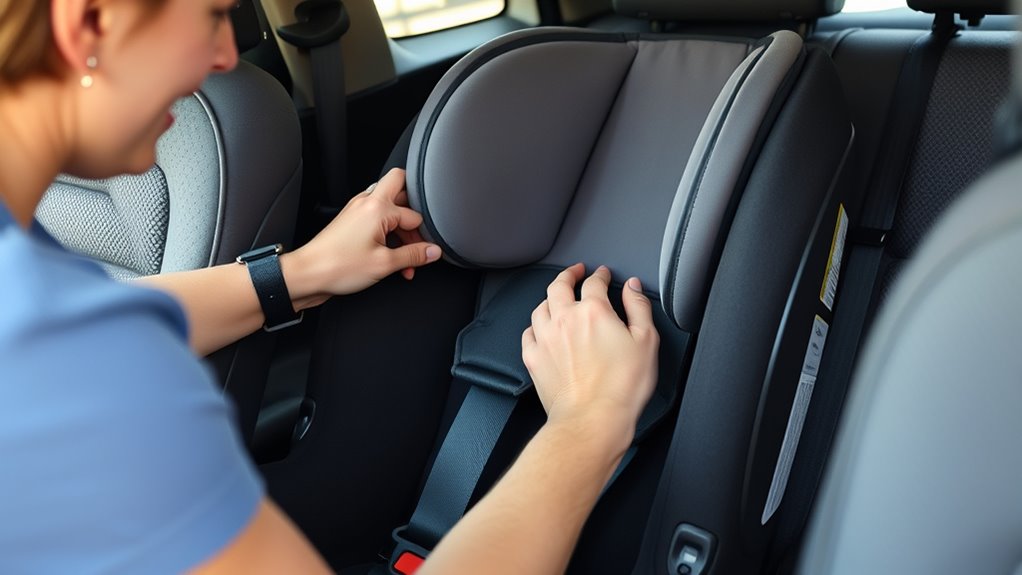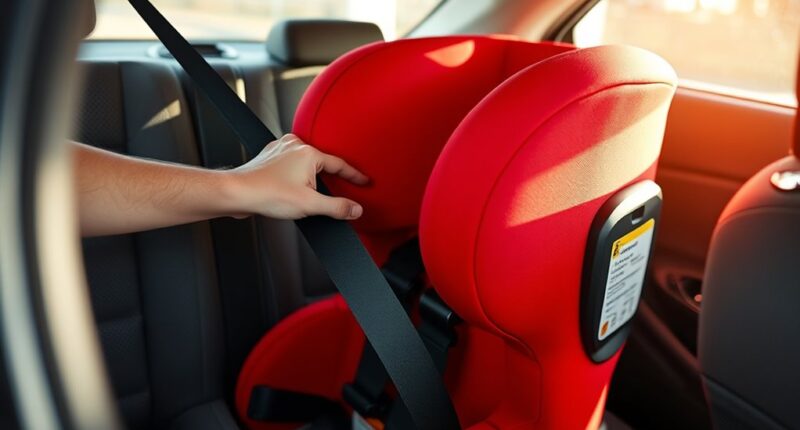Many parents unknowingly make common car seat errors that can compromise safety, like not installing the seat at the correct recline angle or leaving slack in the harness. Ensuring the seat is rear-facing, properly reclined, and that the harness fits snugly at or below shoulder level are key steps. Regularly check and adjust the installation as your child grows. Keep these tips in mind, and you’ll see how simple adjustments can boost your child’s protection every trip.
Key Takeaways
- Proper rear-facing installation with correct seat angle is essential for head, neck, and spine safety during a crash.
- Ensuring the harness is snug, properly positioned at or below shoulder level, and regularly re-tightened prevents slack and injury.
- Regularly inspecting the seat and harness for wear or damage ensures ongoing safety and proper function.
- Common errors include incorrect seat angle, loose harness, and improper installation, which compromise crash protection.
- Following manufacturer instructions precisely and performing routine checks maximizes the seat’s safety effectiveness.

Installing a car seat correctly is essential for your child’s safety, but many parents unknowingly make common errors that compromise protection. One of the most critical aspects is ensuring that your child’s seat is properly installed in a rear-facing position, especially for infants and toddlers. Rear-facing tips are vital because this position offers better support for your child’s head, neck, and spine in the event of a collision. When positioning the seat, make sure it’s installed at the correct angle; most seats have an indicator to help you achieve the proper recline. This angle prevents your child’s head from falling forward and keeps their airway open. Additionally, always follow the manufacturer’s instructions for installation, whether using the seat belt or LATCH system, to guarantee a secure fit.
Equally important is the correct adjustment of the harness. You might think that tightening the harness is simple, but many parents fail to get it snug enough. The harness should be fitted so that it’s snug against your child’s body without causing discomfort. You should not be able to pinch any excess slack at the shoulders; if you can, it’s too loose. Proper harness adjustments are crucial because they keep your child securely restrained during a sudden stop or crash. Regularly check the harness as your child grows, and always ensure the straps are positioned at or below the shoulders for rear-facing seats. This positioning provides optimal protection by distributing crash forces across the strongest parts of your child’s body.
Many parents overlook the importance of frequently inspecting the harness and re-tightening it as needed. Children grow quickly, and a loose harness diminishes the effectiveness of the car seat. Also, avoid placing thick clothing or bulky blankets under the harness, as this can interfere with the seat’s snug fit. Instead, dress your child in thin layers and use the car seat’s built-in harness adjuster to tighten the straps properly. Remember, the goal is to keep your child secure without restricting their movement or comfort.
Frequently Asked Questions
How Do I Choose the Best Car Seat for My Child’s Age and Size?
You should pick a car seat based on your child’s age, height, and weight. Check the child’s height considerations and weight limit guidelines to make certain the seat fits them properly. Look for a seat that accommodates your child’s growth and offers proper safety features. Always follow the manufacturer’s instructions for installation and harness adjustment to keep your child secure and comfortable during every ride.
What Signs Indicate My Car Seat Is Improperly Installed?
If your car seat feels like it’s about to topple over or move more than an inch side to side, you’ve got a serious problem. Common signs of improper installation include loose straps, a wobbly seat, or straps that are too tight or too loose. Check for installation mistakes by testing the seat’s stability; if it shifts excessively, it’s time to re-secure it. Your child’s safety depends on it!
Can I Use Secondhand Car Seats Safely?
You can use secondhand car seats safely if you carefully consider used seat considerations and secondhand safety. Always check for a recent expiration date, visible damage, or missing parts. Confirm the seat hasn’t been involved in a crash, as that compromises safety. Clean it thoroughly, and verify it hasn’t been recalled. If in doubt, investing in a new seat might be safer, but proper inspection can make a secondhand seat a viable option.
How Often Should I Check and Tighten Car Seat Straps?
You should check and tighten your car seat straps before every trip to make certain proper strap adjustment. Regular safety inspections, ideally once a month, help confirm the straps are secure and snug. Keep in mind, straps shouldn’t be too loose or too tight—just enough to pass the pinch test. Consistently maintaining correct strap adjustment and performing safety inspections helps keep your child safe and secure during every ride.
Are There Specific Vehicle Models That Are Harder to Install Car Seats In?
Some vehicle models can be a maze, making installation challenges feel like solving a puzzle. Vehicles with tight spaces or non-standard seat designs often pose more difficulty with vehicle compatibility. Cars with shallow seat angles or irregular seat shapes can make securing a car seat tricky. It’s essential to check your vehicle’s manual and test fit the seat before installation, ensuring safety without frustration.
Conclusion
Now that you know the common installation mistakes, are you confident your child’s car seat is secured correctly? Taking a few extra minutes to double-check can make all the difference in keeping your little one safe. Remember, proper installation isn’t just a step—it’s a responsibility. Don’t leave safety to chance; ask yourself, are you doing everything you can to protect your child every time you hit the road?








